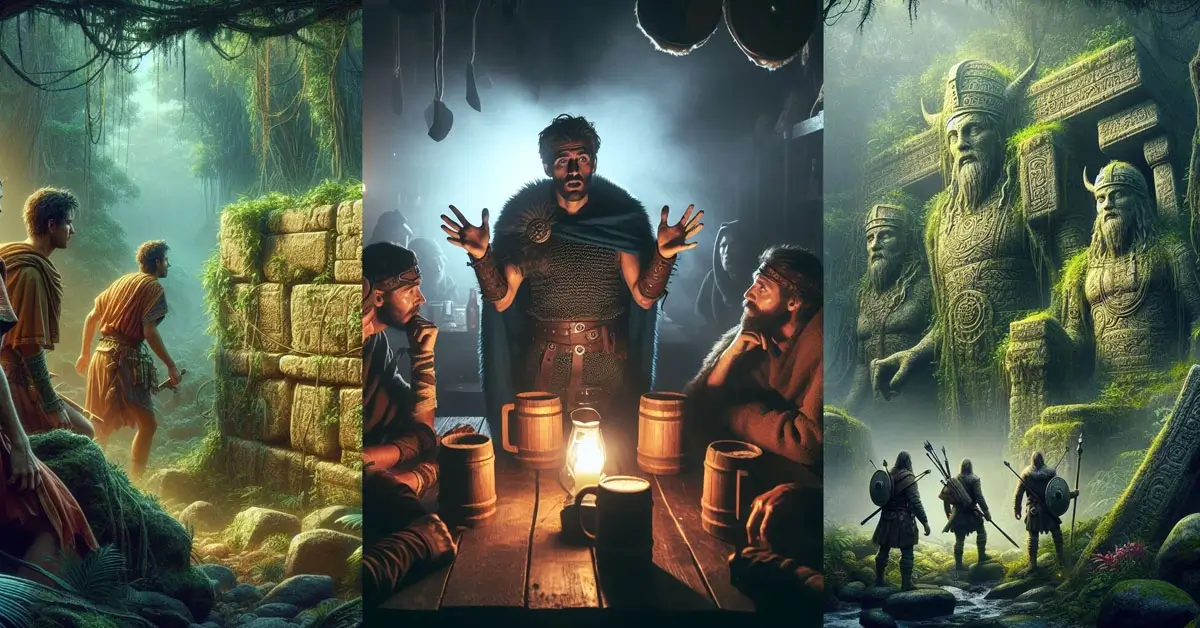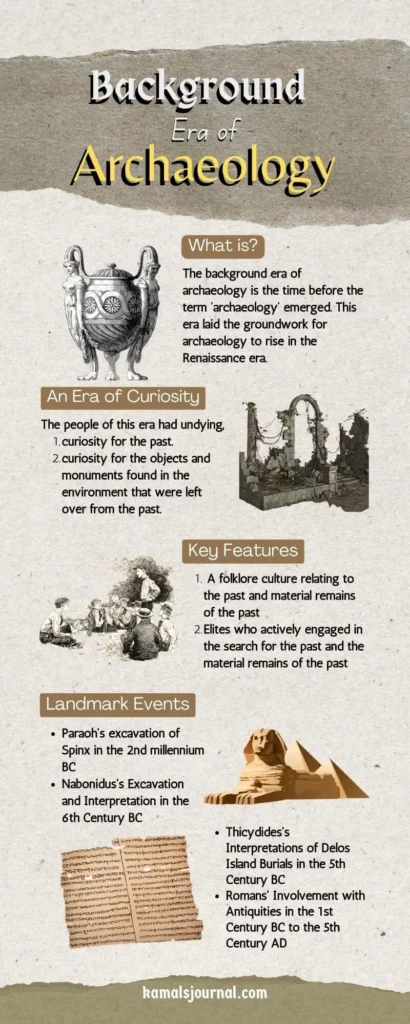The history of archaeology consists of several phases and the first phase can be recognised as the background era. According to the current definition, archaeology is the study of past humans through material remains left from the past. But neither did it originate, as it says in the definition, nor has it always been, as it says in the definition. Because, The origin of archaeology was not a phenomenon. Thus, the history of archaeology is not like a single straight line that began at a certain point in the past and extends through time. The origin of archaeology has always been a gradual process with a background spanning thousands of years.
So, this article is to describe the first period of the history of archaeology, or the Background Era of Archaeology. Additionally, you will find explanations for questions like the history of archaeology timeline, when archaeology first emerged, where archaeology began, etc. Also, this will help to understand what archaeology is.
Introduction to the Background Era of Archaeology
The first age of the history of archaeology is the background era of archaeology. And that was the era when humans first examined their own past. We consider the time from the earliest humans to the Renaissance era as the background era of archaeology. There seemed to be two reasons for humans to be concerned about their past.
- the mere curiosity about the past
- curiosity about the monuments and material remains that they did not know who created
Curiosity about the past is a human trait. As an intelligent species, mankind wonders about its past. So did the people who lived in this background era of the history of archaeology.
Also, they had seen the monuments and other material remains that they did not create. That alone could have triggered curiosity about their past. However, they seemed curious about those monuments and other material remains they found.
Key Features of the Background Era of Archaeology
There are two key features of this era that we can easily determine.
- Folklore relating to the past and material remains of the past
- Elites who actively engaged in the search for the past and the material remains of the past
Driven by the curiosity of the material remains they found, the people in this era and their ancestors created legends, myths, and stories. That folklore culture was constructed around those physical remains and around the people they thought built them in the first place. This folklore culture has passed from generation to generation, growing bigger.
With the capability the elite held in this era to afford to engage in quests in search of the lost cities buried or hidden that were ascribed in the legends, they actively engaged. Unlike the general public, who were limited to the stories, they took a step forward to explore.
Both of these characteristics in this era show the interest people had in the past and their engagement with it. The idea that material remains hold the story of the past was there.
Key Events in the Background Era of the History of Archaeology
There were several important events that happened during the background era of the history of archaeology. It is important to remember that these events show the early stages on the way to archaeology we know today, but not the early stages of archaeology we know today.
These events took place because the background era of archaeology was not only an era when people showed interest in the past or in the material remains that were left from the past. As mentioned above, the elites actively engage in satisfying themselves with their desire to reveal the past. Here are the most significant key events that happened during this era and are significant in the history of archaeology:
Paraoh’s excavation of Sphinx in the 2nd millennium BC
According to the archaeological evidence, the first excavation in history happened during the new kingdom era in Egypt (ca. 1660–1070 BCE). The pharaoh in the new kingdom has excavated and reconstructed the sphinx, which was originally built during the old kingdom (ca. 2575–2134 BCE). Here, it is obvious that the need for ensuring the lifespan of material remains from the past was there before 4500 years. That showed an early form of preservation and conservation that is present in modern archaeology.
Babylon King Nabonidus’ Excavation and Interpretation in the 6th Century BC
Since there are no written records other than archaeological evidence of the paraoh’s excavation of Spinx, the first ever recorded excavation is considered to have been done by Nabonidus, the last king of Babylon (555–539 BCE). He excavated and unearthed the stone foundation of a building dedicated to Naram-Sin, who was a royal in the Akkadian order. Nabonidus even dated the unearthed monument, though the dates were inaccurate by 1500 years. So, here, excavating material remnants that come from the past and giving interpretations based on the excavation results were evident. Those interpretations were simple conclusions that they reached after searching. This was the first ever practical involvement done regarding the history of humankind and the monuments inherent in the past in the documented history. In other words, it was the first documented incident of researching first and then interpreting inherent material from the past.
Thicydides’s Interpretations of Delos Island Burials in the 5th Century BC
In the Classical Greek era, a historian named Thucydides, who lived in Greece (460–400 BC), identified some monuments in the Delos islands as burials and presumed that those burials belonged to an ethnic population called ‘Carians’. This was the first incident in history in which a historian, a person who specialised in studying humanity’s past, studied the material remains and constructed a simple interpretation.
Romans’ Involvement with Antiquities in the 1st Century BC to the 5th Century AD
Then, during the Roman Empire (31 BC–476 AD), Europeans introduced the term ‘antiquities to refer to the monuments and other material remains inherent in the past. Antiquity is a word that gives the meaning of ‘ancient’. And, most importantly, they not only recognised material remains as antiquities but also conserved and exhibited them.
Conclusion
As described, it is evident that mankind, from ancient times to the 15th century AD, was curious and passionate about their past and the monuments inherent in it. Apparently, the monuments inherent in the past have been appealing enough for people to study the past. Clearly, this led to the gradual emergence of practices and trends during the period. One significant practice introduced was identifying monuments and other material remains inherent in the past as antiquities. The trend of constructing folk stories connecting the antiquities to the ancestors who lived in the past was a significant feature. Similarly, looking for antiquities in order to investigate them and their legends was a prominent feature of this era. Furthermore, unearthing, collecting, and then exhibiting antiquities was popular during this time period.
By the end of this era, common practices of searching for, unearthing, collecting, and displaying antiquities were more for aesthetic purposes than for historical research. However, even though a specific discipline did not develop, the basic concept for such a discipline was developed during this era. Hence, this era is termed ‘the conceptual age of studying the past’. Because the concept of studying the past was there. Therefore, this era is the first era of the history of archaeology or the first era of the development of archaeology. The European Renaissance succeeded this era. The Renaissance era marked the second phase of the history of archaeology, taking the concept of studying the past to the next level.
Read the next article>> Archaeology in the Renaissance Era


